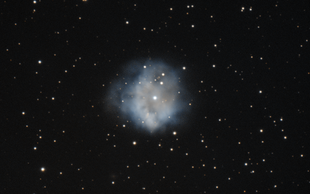NGC 6026
|
Planetary Nebula NGC 6026 |
|
|---|---|

|
|
| Image taken with a Very Large Telescope | |
| AladinLite | |
| Constellation | wolf |
|
Position equinox : J2000.0 |
|
| Right ascension | 16h 01m 20.9s |
| declination | -34 ° 32 ′ 39 ″ |
| Appearance | |
| Apparent brightness (visual) | 12.9 mag |
| Apparent brightness (B-band) | 13.2 mag |
| Angular expansion | 0.67 ′ × 0.67 ′ |
| Central star | |
| Physical data | |
| Radial velocity | −87 km / s |
| distance | 2398 pc |
| history | |
| discovery | John Herschel |
| Date of discovery | June 8, 1837 |
| Catalog names | |
| NGC 6026 • ESO 389-PN7 • GC 4154 • h 3617 • | |
NGC 6026 is a 12.9 likes bright planetary nebula in the constellation Wolf and about 2400 parsecs from Earth.
It was discovered on June 8, 1837 by John Herschel with an 18-inch reflector telescope, which was named “F, S, R, 15 arcseconds, gpmbM. There are three stars forming a triangle about 60 degrees, Np the nebula "noted.